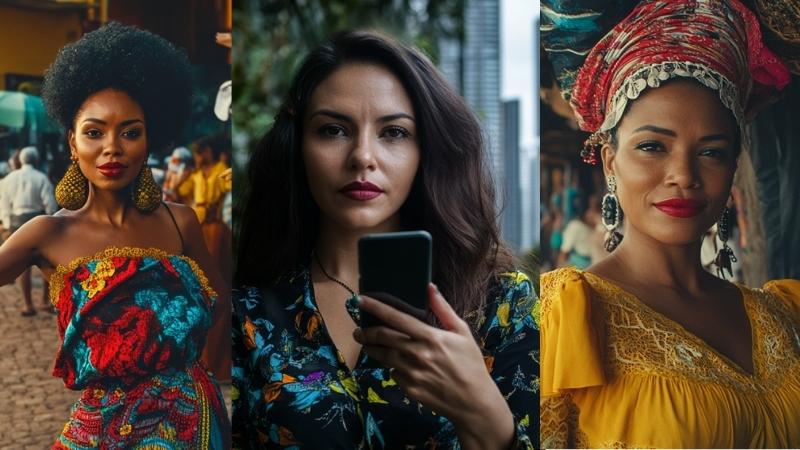
Stereotypes about Brazilian women flood media, travel blogs, and pop culture. These oversimplified images create false impressions. The truth goes much deeper.
Brazil holds a complex mix of cultures, identities, and life experiences that shape the real lives of its women. Every region, every city, every community adds layers to what it means to be a Brazilian woman. No single image or trait can define them.
The truth about Brazilian women cannot be found in Carnival snapshots or travel fantasies. It requires honesty, cultural respect, and a clear look at history and reality. Brazilian women lead in politics, build careers in science, create movements in art, and shape families with strength and resilience.
Yet, none of those realities appear in the surface-level assumptions many outsiders believe.
To find the truth, stop looking at what stereotypes offer. Look instead at what they hide. Real stories replace assumptions. Real voices break down tired myths. This article opens that door.
Beyond the Bikini: Where the Stereotypes Begin
The world saw a bikini and thought it understood Brazilian women. That is where most of the trouble started.
For decades, postcards, TV shows, and travel blogs kept showing the same image. A woman on the beach. Tanned skin. Big smile. Always in motion. Always there to entertain.
That image stuck. It became the shortcut people used to describe millions of very different women across one of the most complex countries on earth.
The Tourist Fantasy

Every summer, tourists land in Rio de Janeiro or Salvador and think they walked into a dream. Music fills the air. Beach life never stops. But the version they see is not everyday life for most Brazilian women. The beach is a backdrop. The woman in the bikini is part of a party, not a picture of a culture.
People visit for a week and leave thinking they met the entire country. They leave believing Brazilian women act the same, dress the same, think the same.
They never visit Acre or Minas Gerais. They never talk to a judge, a farmer, a high school teacher. They see fun and mistake it for fact.
Where Real Life Starts
Not every woman in Brazil lives near a beach. Not every woman dances samba. Some do not care about Carnival at all.
Many work two jobs, raise children alone, lead businesses, or study in universities that outsiders cannot pronounce. Some women dress modestly. Some wear jeans and sneakers. Some go to church more than they go out.
Even in cities like Rio, life looks different once you step away from tourist neighborhoods. In suburbs, in working-class communities, and in rural towns, Brazilian women live full lives no postcard ever captures.
Breaking the Frame
The stereotype does not hurt only because it is lazy. It hurts because it flattens everyone into one photo. It creates pressure.
Some women feel pushed to fit the image, even when they never chose it. Others feel invisible if they do not match it.
Single chubby women in Brazil, for example, often get ignored by foreigners chasing a fantasy. They get left out of the story altogether.
But inside Brazil, beauty takes many shapes. Confidence comes in every size. Local dating scenes tell a very different story than the one tourists bring home.
Faces of Brazil: One Country, Many Women
Brazil does not speak with one voice. Its women do not move through life in one rhythm. Every region, every state, every city adds new layers to what it means to be a Brazilian woman.
North Is Not South

Women in the Amazon region live completely different lives than women in São Paulo. Some live close to rivers, grow their own food, and speak Indigenous languages alongside Portuguese.
Others navigate crowded urban streets, chase office deadlines, and build careers in tech, law, or media.
In the south, there are families with German or Italian roots. In Bahia, Afro-Brazilian culture leads daily life. Go west, and you will find rural communities that feel nothing like the coast. The food changes.
The music changes. The fashion shifts. So do the values. Try to squeeze all that into one stereotype, and it falls apart fast.
No Single Standard
There is no universal way a Brazilian woman should look or act. Hair textures, skin tones, accents, and traditions vary across regions. Some women wear box braids. Some wear straight hair.
Some speak softly. Others do not. Some grew up Catholic. Others grew up Candomblé or Evangelical. Some walk miles to school. Others ride elevators to skyscrapers.
Those differences matter. They shape how women see themselves, how they connect to others, and how they push forward through life. To ignore that complexity is to erase real people.
What Outsiders Miss
Most stereotypes about Brazilian women come from people who only look at one city or one event. Carnival becomes the map. Rio becomes the model.
Anything outside that narrow lens gets treated like an exception. But Brazil is not one city. It is a continent-sized country packed with contrast.
Dating Myths
Romance in Brazil carries its own history, its own codes, and its own pace. Foreigners often come with expectations shaped by movies, music videos, or hearsay. Most of those ideas fall apart quickly.
Real Women Want Real Connection
Brazilian women do not want to be chased like objects. They want to be seen as full people. Some seek deep commitment. Others want independence. Some prefer slow steps. Others are open and direct.
The common thread is this: respect matters more than charm.
Foreign men who arrive thinking that Brazilian women are easy often leave disappointed.
Real love does not grow on stereotypes. It grows when two people meet as equals, without games or roles forced by culture.
Every Story Is Different
There are women who value tradition. There are others who challenge it. Some wait to marry. Some never plan to. Some date inside their culture.
Others welcome partners from abroad. Nothing fits one mold.
Voices of Power: Stories That Shatter the Mold
Women in Brazil do not wait for permission to lead. They shape communities, change laws, and fight systems built to keep them silent.
Their power does not come from fantasy. It comes from work, focus, and truth.
Leaders Who Speak for Themselves
View this post on Instagram
Marielle Franco stood up in Rio de Janeiro as a Black, queer city councilwoman. She fought police violence and injustice in favelas. Her voice reached across Brazil. Her assassination in 2018 shook the nation, but it did not silence the movement she helped grow.
Djamila Ribeiro writes and lectures about race and feminism across Brazil. She makes space for voices often pushed out of public life. Her books reach classrooms and street corners. She challenges both government policy and daily bias with equal force.
Ana Paula Padrão broke barriers in journalism.
Marta Vieira da Silva did the same in football.
Countless others shape Brazil every day, in medicine, education, music, and tech. None of them fit the stereotypes sold to tourists.
Religion, Family, and Social Values
Brazilian women carry stories shaped by culture, but also by values passed through family and faith.
Those values often clash with the shallow images foreigners bring in. No costume or party can explain that.
The Role of Faith
Many of them practice religion in strong, personal ways. Catholicism still holds deep roots, but Evangelical churches have grown fast.
Afro-Brazilian religions like Candomblé and Umbanda offer spiritual paths that mix African and local traditions.
In all cases, faith becomes a foundation. It shapes how women raise children, view relationships, and face struggles.
The outsider idea that women in Brazil live only for fun misses this deeper layer. Faith keeps many grounded. It gives strength in hard moments and guidance when choices must be made.
Family First
Family ties run deep in Brazil. Women carry heavy responsibility at home. They raise children, care for aging parents, and support relatives through school or work.
Some live in multigenerational homes where respect for elders shapes daily decisions. Others work long hours but still manage meals, homework, and budgets.
That level of care takes focus and strength. It is not about sacrifice. It is about pride. Many women see this role not as a burden, but as proof of resilience.
What Brazilian Women Want You To Know
No one speaks for all Brazilian women. Still, certain truths come up again and again. Ask them what they wish outsiders knew, and the answers carry force.

“See Us as People, Not Stereotypes”
Many women say the same thing in different ways. They want to be approached with respect, not assumptions.
That means listening without guessing. Asking without expecting one kind of answer. Learning without turning culture into a costume.
“We Are Not a Fantasy”
The fantasy is tiring. It flattens every woman into the same mold. It turns life into a postcard.
They want you to see past that. To ask about their work, their city, their ideas. To see their full lives. Some are artists. Some run farms. Some are single chubby women tired of being left out. All deserve to be seen as whole.
“Look at the Country You Missed”
Brazil is not one beach or one parade. It is cities, forests, farms, villages, and neighborhoods full of life that never make it to the travel ads.
Final Thoughts
Stereotypes about Brazilian women do not survive close attention. They fade fast once you listen to real voices, visit real places, and ask better questions.
The bikini, the party, the flirt—those images came from the outside. They never told the full story.
















